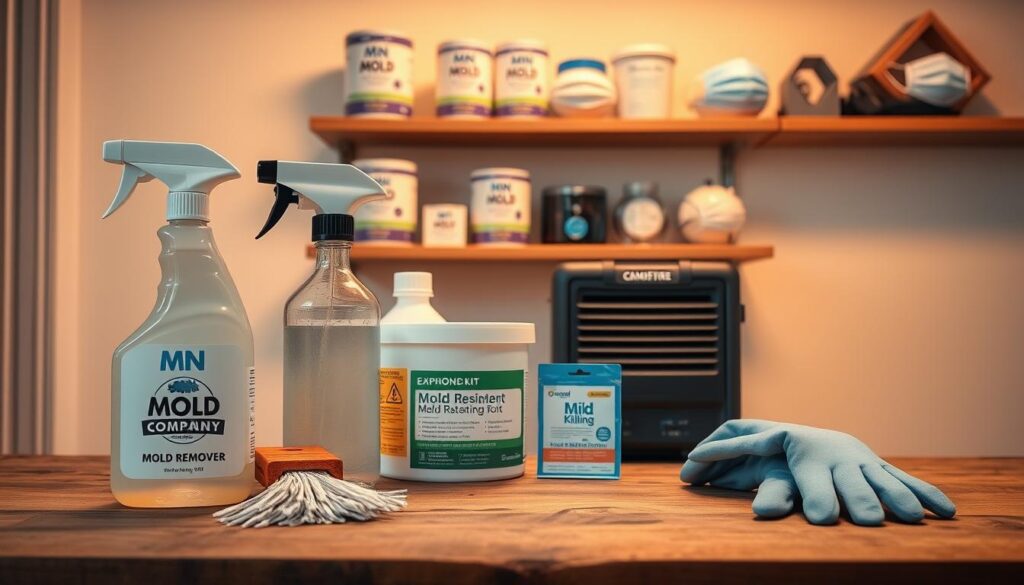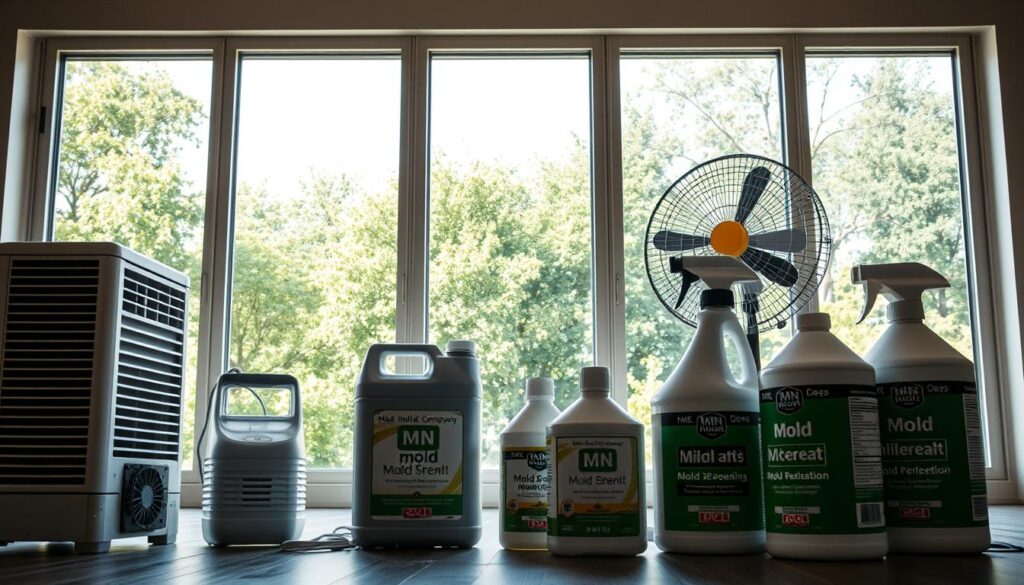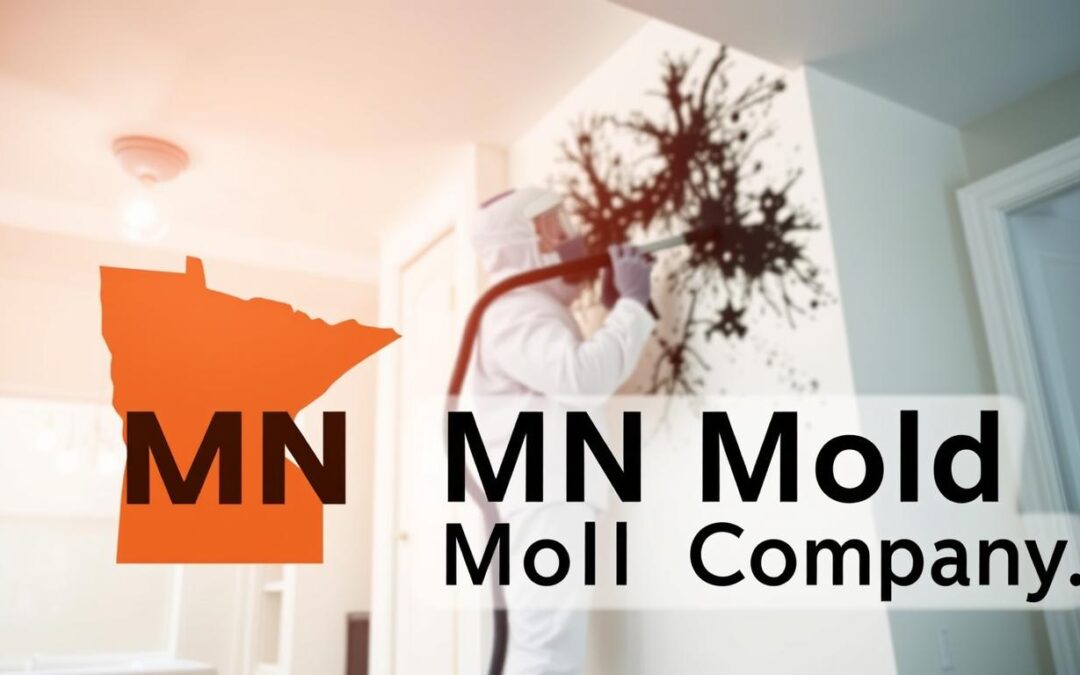Are you worried about the health risks posed by black mold in your home? Understanding how to address this issue safely and effectively is crucial for protecting your family and property. Black mold, a toxic fungus, thrives in moist environments and can lead to serious respiratory issues if left unchecked.
Mold spores are everywhere, even in dry climates, and they can quickly colonize when conditions are right. Regular cleaning and preventive maintenance are essential to stop mold growth before it becomes a problem. This guide offers both DIY solutions and professional remediation methods, ensuring you have the tools to tackle mold safely.
Our certified technicians provide free mold inspections and easy online booking—reach us at 612-477-0804 to schedule your service. Don’t risk your health; learn how to remove mold and keep your home safe and clean.
Key Takeaways
- Black mold poses significant health risks, especially respiratory issues.
- Regular cleaning and moisture control prevent mold growth.
- Both DIY and professional methods are effective for mold removal.
- Free inspections and certified technicians ensure safe remediation.
- Immediate action is crucial to avoid mold-related health problems.
Understanding Black Mold and Its Impact
Black mold, a type of fungus, is a common concern for many homeowners due to its potential health risks and ability to spread quickly in damp environments. While it’s not always literally black, it can appear in various shades, making it tricky to identify without proper inspection.
Health Risks Associated with Black Mold
Exposure to black mold can lead to a range of health issues, particularly for individuals with preexisting conditions. According to the National Institute of Environmental Health Sciences, symptoms can include respiratory problems, allergic reactions, and even asthma attacks in sensitive individuals. Those with weakened immune systems, such as people with HIV or undergoing cancer treatment, are at a higher risk of developing fungal infections.
How Mold Spores Thrive in Your Home
Mold spores are everywhere, even in the cleanest environments. They thrive in damp, poorly ventilated areas where moisture is present. Leaky pipes, condensation, and high humidity create the perfect conditions for mold growth. In fact, mold can begin to grow just 24-48 hours after moisture is introduced to an area. Proper ventilation is key to preventing mold growth, as it helps reduce moisture levels in the air.
“Maintaining indoor humidity levels below 50% is crucial to preventing mold growth, as recommended by the CDC.”
Factors like improper air circulation and damp environments can quickly turn into a mold problem. Regular cleaning and addressing issues like condensation or water leaks can help prevent mold from taking hold. By understanding the conditions that allow mold to grow, homeowners can take proactive steps to protect their health and property.
Recognizing Black Mold: Signs and Symptoms
Identifying black mold early is key to preventing its spread and related health issues. Common areas to check include bathrooms, basements, and any space with poor ventilation or water damage.
Visible Signs and Affected Areas
Black mold often appears as black, greenish, or dark brown spots on surfaces. Look for these signs:
- Black spots on walls, ceilings, or tiles
- Water stains or peeling paint
- A musty, unpleasant odor
Hidden Mold Behind Drywall and Other Surfaces
Mold can grow unnoticed behind walls or under flooring. Signs include:
- Warping or discoloration of walls
- Musty smells without visible mold
When to Seek Professional Help
Consult experts if:
- The infestation covers a large area
- Health symptoms persist
- DIY efforts fail
| Area | Surface | Action |
|---|---|---|
| Bathroom | Tile, Grout | Check for water damage |
| Basement | Walls | Look for damp spots |
| Kitchen | Countertops | Inspect for leaks |
Early detection prevents severe mold growth and health risks. Don’t hesitate to contact professionals if you suspect an issue.
How to Remove Black Mold
When dealing with black mold, homeowners have two main options: tackling it themselves or hiring professionals. Each method has its pros and cons, and understanding these can help you make an informed decision.
DIY Techniques
For small areas of mold growth, DIY methods can be effective. Start by mixing a solution of bleach and water, typically 1 part bleach to 10 parts water. Apply the solution to the affected area using a spray bottle. Let it sit for about 15 minutes to ensure it penetrates deeply. Always wear protective gear, including gloves and a mask, to minimize exposure to harsh chemicals and spores.
Professional Remediation
Professional services are recommended for larger infestations or sensitive areas. Experts use specialized equipment and follow safety protocols to ensure complete removal and prevent cross-contamination. They also handle the disposal of infected materials, making the process safer and more efficient.
| Method | Pros | Cons |
|---|---|---|
| DIY | Cost-effective, quick for small areas | Risk of incomplete removal, health hazards |
| Professional | Thorough removal, safety assurance | Higher cost |
Regardless of the method chosen, safety should always come first. Use appropriate cleaning agents like vinegar or baking soda for a natural approach, and ensure the area is well-ventilated. If the infestation is widespread or you experience severe symptoms, don’t hesitate to seek professional help.
Selecting the Right Tools and Ingredients
When tackling mold removal, choosing the right cleaning agents is essential for effective results. Whether you prefer commercial products or natural remedies, understanding their strengths and limitations will help you make informed decisions.
Effective Cleaning Agents: Bleach, Vinegar, and Baking Soda
Bleach is a powerful solution for non-porous surfaces like tile or glass. Mix 1 cup of chlorine bleach with 1 gallon of water for a strong disinfectant. Vinegar, on the other hand, is a natural alternative that’s effective against mold without harsh chemicals. Baking soda is another versatile option, often used for scrubbing mold from surfaces safely.
Natural Home Remedies and Their Limitations
Natural remedies like vinegar and baking soda are eco-friendly and gentler on surfaces. However, they may not be as effective on large or deeply rooted mold infestations. For such cases, professional products containing quaternary ammonium compounds (quats) or enzyme-based removers are more reliable.
| Cleaning Agent | Pros | Cons | Best Surface |
|---|---|---|---|
| Bleach Solution | Strong disinfectant, cost-effective | Harsh on surfaces, toxic fumes | Non-porous surfaces |
| Vinegar | Natural, non-toxic | Less effective on large areas | All surfaces |
| Baking Soda | Gentle abrasive, odor-neutralizing | May require repeated use | Porous surfaces |

Always follow directions precisely to avoid damaging surfaces, especially wood or drywall. For wood surfaces, sanding may be necessary before cleaning. Remember, while natural remedies are effective for small areas, professional products are often needed for extensive mold growth.
Professional Mold Services: What to Expect
Dealing with mold can be overwhelming, but professional services offer a reliable solution. Our certified technicians provide thorough mold removal, ensuring your home is safe and clean.
Free Mold Inspections and Certified Technicians
Our free inspections are conducted by certified experts who assess the severity of mold growth. They use state-of-the-art equipment to identify hidden mold and recommend the best course of action. This ensures safe and effective removal, giving you peace of mind.
Easy Online Booking for Mold Assessments
Scheduling an inspection is quick and easy. You can book online or call us at 612-477-0804 for immediate assistance. Our system is designed to handle your needs efficiently, ensuring a prompt response and minimal disruption to your routine.
| Service | Features | Benefits |
|---|---|---|
| Professional Mold Removal | State-of-the-art equipment, certified technicians | Thorough removal, reduced health risks |
| Free Inspection | Comprehensive assessment, expert recommendations | Identifies hidden mold, cost-effective |
| Easy Online Booking | 24/7 availability, quick scheduling | Convenience, fast response time |
Our professional mold services are designed to be efficient and reliable. With a focus on safety and effectiveness, we ensure your home is mold-free and secure. Don’t hesitate to reach out for a free inspection and take the first step towards a healthier living environment.
Preventing Future Mold Growth
Taking proactive steps to prevent mold growth is essential for maintaining a healthy and safe living environment. By focusing on improving ventilation and controlling moisture, you can significantly reduce the risk of mold recurrence.
Improving Ventilation and Air Circulation
Proper ventilation is key to reducing moisture in the air, which mold thrives on. In areas like bathrooms and kitchens, where moisture is most prevalent, installing exhaust fans or ensuring windows are open after showers can make a big difference. A well-ventilated home not only reduces mold growth but also improves indoor air quality.
Moisture Control and Preventative Maintenance
Keeping moisture levels low is crucial. Use dehumidifiers in humid areas and fix any water leaks promptly. Regularly inspecting your home for signs of dampness and ensuring good airflow can prevent mold from taking hold. Monitoring humidity levels with a hygrometer is a practical step to maintain a balanced environment.

| Area | Action | Benefit |
|---|---|---|
| Bathroom | Use exhaust fans | Reduces moisture |
| Basement | Ensure good airflow | Prevents dampness |
| Kitchen | Install ventilation | Improves air quality |
By implementing these strategies, you can create an environment where mold is less likely to grow, ensuring a healthier and safer home.
Maintenance and Long-Term Solutions
Keeping your home free from mold requires consistent effort and a well-planned maintenance routine. Regular inspections and professional follow-ups are essential to ensure your environment remains safe and healthy.
Regular Inspections and Early Detection
Scheduling regular inspections is crucial for catching mold before it becomes a major issue. Focus on areas prone to moisture, such as bathrooms and walls. Early detection can prevent costly repairs and health risks.
Use a hygrometer to monitor humidity levels, aiming to keep them between 30-50%. This simple step can significantly reduce the chance of mold growth.
Incorporating Professional Follow-Up Services
After addressing a mold issue, professional follow-ups ensure the problem doesn’t recur. Certified services can provide thorough checks and recommend tailored solutions for your home’s specific needs.
To create a sustained prevention plan, integrate professional services into your home maintenance routine. This proactive approach not only saves time but also offers peace of mind.
Conclusion
Addressing mold growth is crucial for protecting both your health and your home. Black mold, in particular, poses serious risks, including respiratory issues and allergic reactions, especially for vulnerable individuals. Whether you choose DIY methods or professional services, swift action is essential to prevent further damage and health complications.
For small infestations, DIY techniques using natural cleaners like vinegar or baking soda can be effective. However, larger areas or severe growth require professional intervention to ensure complete removal and safety. Regular inspections and improving ventilation are key to long-term prevention.
Don’t wait—prompt action can prevent mold from becoming a costly and dangerous issue. Our certified technicians offer free inspections and easy online booking, providing you with peace of mind and a mold-free home. Call us at 612-477-0804 today to schedule your service and take the first step toward a healthier living environment.
FAQ
What are the health risks associated with black mold exposure?
Black mold can cause respiratory issues, allergies, and other health problems. It’s especially dangerous for people with weakened immune systems. Always handle mold removal carefully to protect your family’s health.
How can I prevent black mold from growing in my bathroom?
Improve ventilation by using an exhaust fan after showers. Regularly clean surfaces with a solution of water and vinegar, and fix any water leaks promptly to prevent moisture buildup.
What’s the best way to clean black mold from bathroom tiles?
Mix equal parts water and chlorine bleach, spray the area, and let it sit for 10 minutes. Scrub gently with a brush, then rinse and dry thoroughly. Always wear gloves and a mask for safety.
Can I use vinegar alone to remove black mold?
Vinegar is effective for small areas of mold growth. However, for larger infestations, a solution of chlorine bleach and water is more reliable. Always test a small area first to ensure the product works without damaging the material.
How long does it take to remove black mold from drywall?
Removal time depends on the size of the affected area. Small areas may take about 30 minutes, but larger sections could require several hours. If the mold has deeply penetrated the drywall, it’s best to call a professional.
What should I wear when cleaning black mold?
Wear long sleeves, long pants, rubber gloves, and a face mask rated for mold spores. This protective gear helps prevent skin contact and inhalation of mold particles.
How can I improve ventilation to reduce mold growth?
Open windows, use fans, and ensure proper airflow in humid areas like bathrooms and kitchens. Installing a whole-house ventilation system can also help maintain a dry environment.
Is baking soda effective against black mold?
Baking soda can help absorb moisture and reduce mold odors, but it’s not a complete solution. For effective removal, pair it with a cleaning agent like vinegar or bleach.
When should I call a professional for mold removal?
If the mold covers a large area (more than 10 square feet) or if you’re unsure about the type of mold, it’s best to contact a certified professional. They have the tools and expertise to safely handle the situation.
How can I stop black mold from coming back?
Fix any water leaks, improve ventilation, and regularly inspect areas prone to moisture. Using a dehumidifier can also help create an environment less conducive to mold growth.
Source Links
- Have Black Mold in Your Home? Getting Rid of It Is Easier Than You Think – https://www.thespruce.com/how-to-get-rid-of-black-mold-5199449
- How to Get Rid of Black Mold – https://www.homedepot.com/c/ah/how-to-get-rid-of-black-mold/9ba683603be9fa5395fab90a432a6d0
- Get Rid of Black Mold From Showers, Walls, and Wood – https://www.realsimple.com/how-to-get-rid-of-black-mold-7253636
- Black mold exposure: Symptoms, treatment, and prevention – https://www.medicalnewstoday.com/articles/323419
- Black Mold Exposure: Symptoms, Risks & Treatment – https://my.clevelandclinic.org/health/diseases/24862-black-mold
- Can Black Mold Kill You? – https://www.webmd.com/lung/can-black-mold-kill-you
- Signs Of Black Mold: How Do You Know If You Have Black Mold? | HRS Restoration Services – https://www.hrsrs.com/blog/signs-of-black-mold-in-a-house/
- What Is Black Mold? – https://www.healthline.com/health/black-mold-exposure
- 3 Signs of Black Mold and How to Get Rid of It – https://www.wawanesa.com/us/blog/3-signs-of-black-mold-and-how-to-get-rid-of-it
- Black Mold Remediation: How to Clean Black Mold – https://www.puroclean.com/blog/black-mold-removal-and-remediation/
- How To Remove Mold From Your Home – https://www.progressive.com/lifelanes/home-mold-removal-tips/
- How to Kill Black Mold: 18 Specialist-Approved Tips – https://www.wikihow.com/Kill-Black-Mold
- How to Get Rid of Mold – https://www.homedepot.com/c/ah/how-to-get-rid-of-mold/9ba683603be9fa5395fab907c52351c
- Mold Removal Products: How to Choose the Right One – https://www.krausrestoration.com/how-to-choose-the-right-mold-removal-products/
- What to Expect During the Mold Remediation Process – https://callservicefirst.com/what-to-expect-during-the-mold-remediation-process/
- Professional Mold Removal and Mold Remediation: What To Expect – https://unitedwaterrestoration.com/blog/professional-mold-removal-and-remediation-what-to-expect/
- Moisture and Mold Problems: Preventing and Solving Them in Your Home – https://www.webmd.com/lung/mold-mildew
- How to Get Rid of Mold and Mildew (and Prevent It from Coming Back) – https://www.bhg.com/how-to-get-rid-of-mold-and-mildew-8674585
- Remove Mold For A Healthy Home – https://www.ndsu.edu/agriculture/extension/publications/remove-mold-healthy-home
- How Can I Get Rid Of Mould Permanently? | EnviroVent – https://www.envirovent.com/help-and-advice/why-ventilate/mould-problems/how-can-i-get-rid-of-mould-permanently/
- How to Get Rid of Black Mold for Good – https://www.countryliving.com/home-maintenance/cleaning/a27379221/black-mold-removal/
- Removing Mold in Your Home – https://extension.uga.edu/publications/detail.html?number=C1047-2&title=removing-mold-in-your-home
- How to Get Rid of Black Mold Safely – https://www.puroclean.com/zephyrhills-fl-puroclean-certified-restoration-specialists/blog/how-to-get-rid-of-black-mold/
- The Ultimate Guide on How To Clean and Get Rid Of Mold – https://prohousekeepers.com/blog/ultimate-mold-cleaning-guide/

